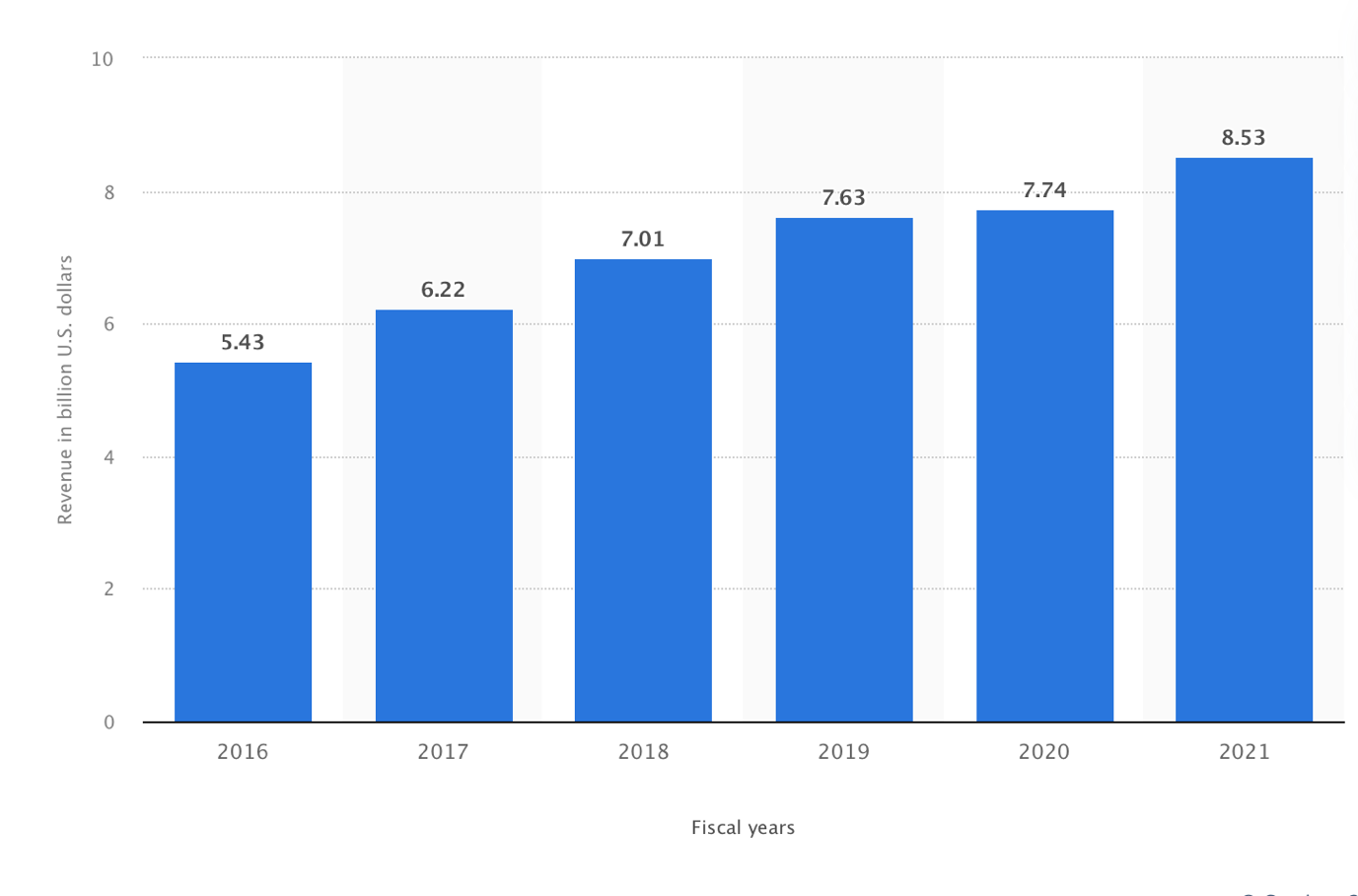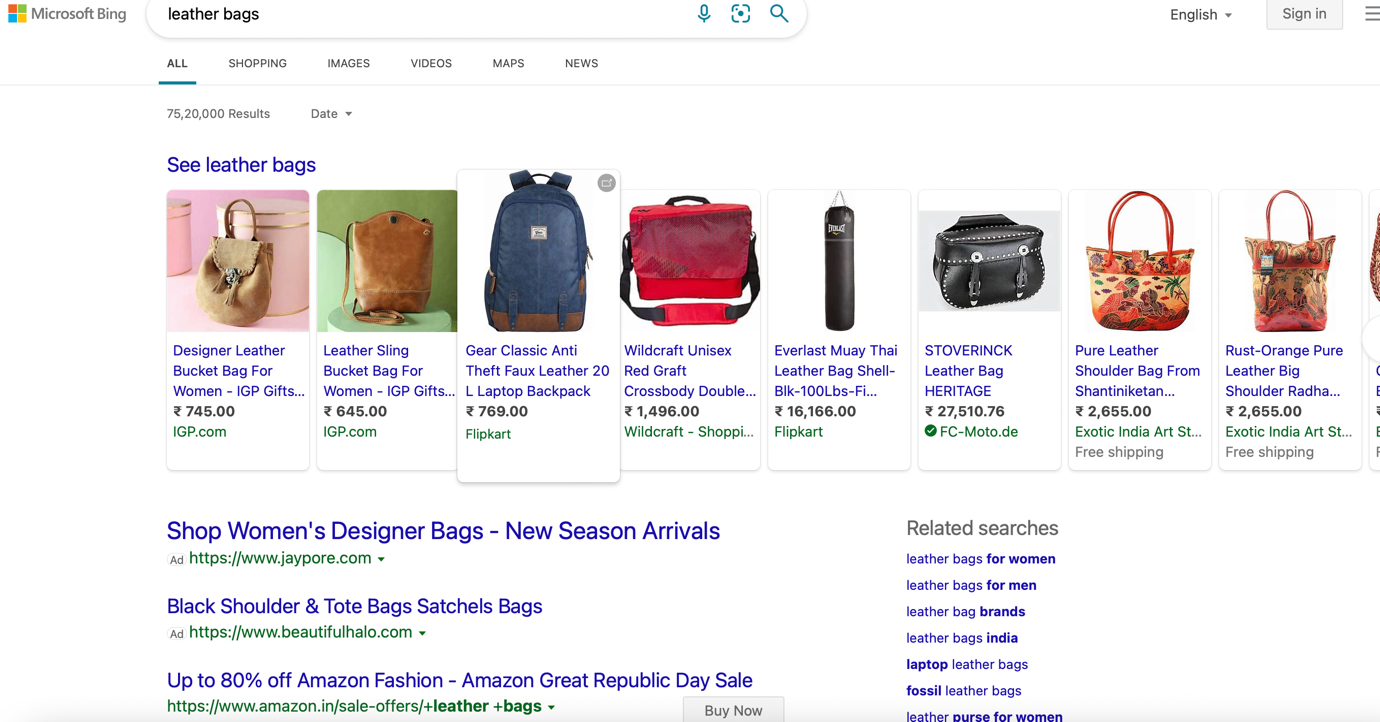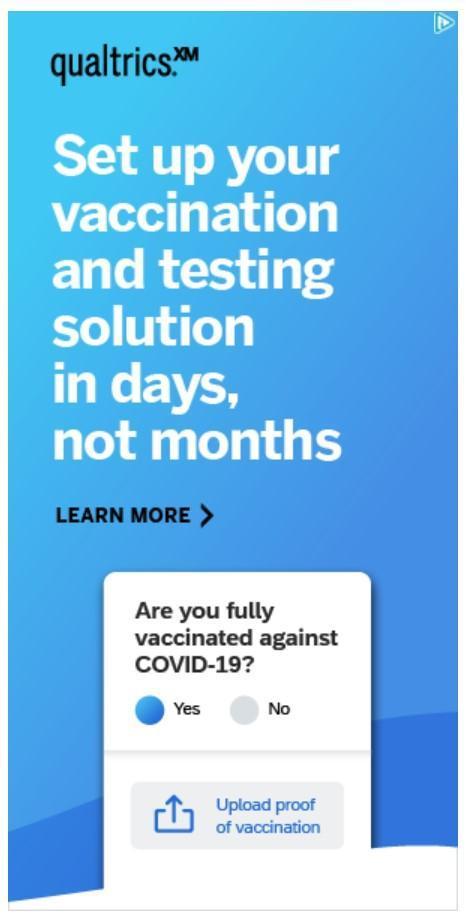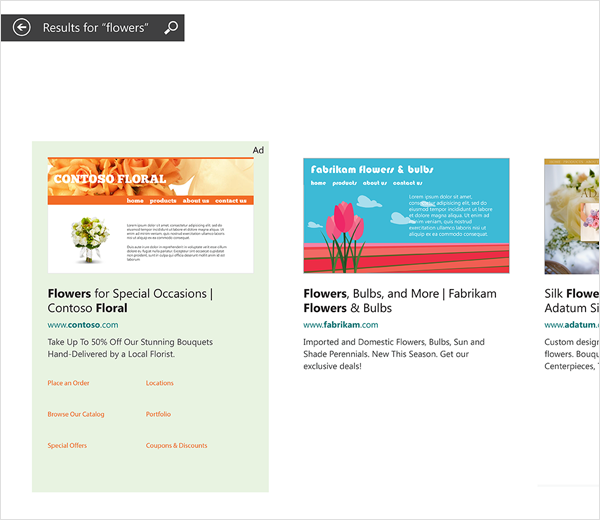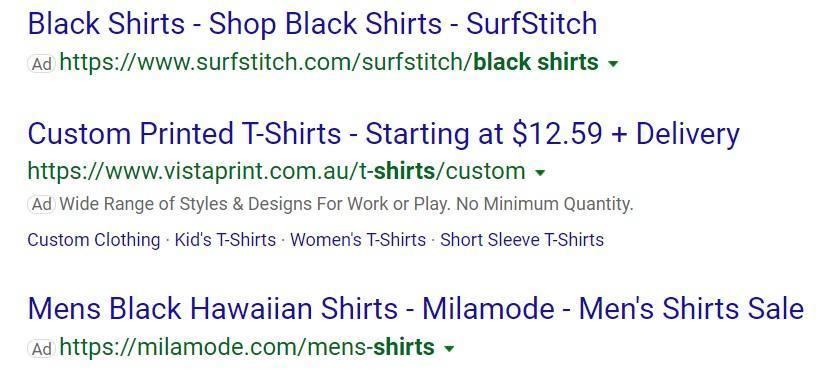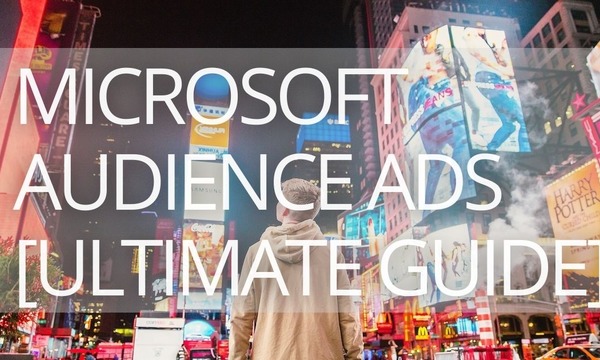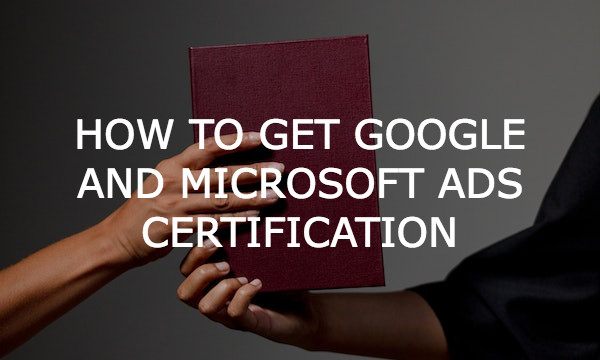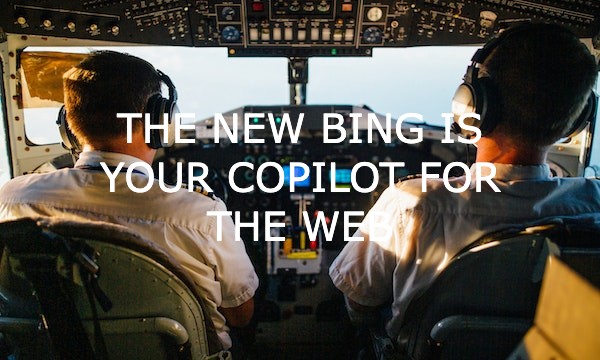Despite Bing accounting for only 7.2% of the global search market, it’s still the second most popular engine worldwide. In 2021, Microsoft’s ad revenue stood at a staggering $8.53 billion—which means despite Bing holding a mere 7.2% of global search market share, businesses are investing their top dollars in Microsoft Ads.
Here’s a data graph representing Microsoft’s search advertising revenue between 2016 and 2021.
As you can see, Microsoft’s search engine (Bing) is growing at a decent rate. Businesses are spending thousands of dollars each quarter to reach out to their target audience on Bing.
And if you have been planning to run strategic Microsoft ad campaigns but are in the initial stages of planning your journey, you’re in the right place.
Throughout this blog post, we’ll shed light on:
- What is Microsoft Advertising?
- How Does Microsoft Advertising Work Exactly?
- 8 Microsoft Ad Campaign Types You Should Become Familiar with
Without further ado, let’s dive straight into the realm of Microsoft Advertising.
What is Microsoft Advertising?
Over the course of the last few years, we’ve been witnessing businesses invest billions of dollars in PPC advertising. And with Google holding over 86.19% of the overall market share, most businesses prefer advertising on Google.
BUT! What they fail to realize is that despite Bing’s 7.2% market share, over 1.08 billion people worldwide use Bing. Bing’s monthly search volume stands at a staggering 12 billion. That’s incredible!
Previously called Bing Ads, Microsoft Ads is Microsoft’s advertising platform that allows business owners and advertisers to build and run highly strategic ad campaigns.
We conducted a quick search of the term “leather bags” on Bing and found the following results:
From product ads to expanded text ads to smart search ads, you’ll see different types of businesses running different types of ads to put their products and services in front of their customers.
The thing is—most businesses are so laser-focused on running Google ads that they have failed to realize the full potential of Bing Ads. And with an ever-increasing number of businesses advertising on Google, the chances of your ads appearing on the first page are quite slim (especially if you are targeting generic keywords)—unless you have a gigantic budget.
While Bing’s global search market share is comparatively much lower than Google’s, and taking into consideration the fact that over 1.08 billion people use Bing on a monthly basis—it’s a brilliant opportunity. On top of this, not many businesses are running Microsoft ads—which means Bing’s advertising landscape is not as competitive as Google’s. So, the chances of your ads appearing at the top of Bing SERPs for relevant keywords are quite high at a budget-friendly price.
That being said, let’s learn how Microsoft Ads work.
How to Import Google Ads Campaigns to Microsoft (Bing) Advertising
How Does Microsoft Advertising Work Exactly?
In a nutshell, here’s how Microsoft Advertising works:
- Let’s say a person looked up a keyword or searched for a term like “leather bag” on Bing.
- Bing will process the query and fetch relevant results to show the user. These results will include both ads and organic results.
- The ads will be shown at the top—above organic results. However, their placement is not permanent. The placement of these ads is subject to different factors and as soon as you stop pouring in your money and pause/stop your campaigns, your ads will disappear.
- The other part is organic results—these are businesses ranking at the top for relevant keywords.
- Depending on your business, the product you’re selling, the industry you belong to, and various other factors, you can prepare a list of the keywords you’d like to target. When you build Microsoft ad campaigns and begin running ads, people looking up the keywords you’ve chosen will be able to find your ads. Upon clicking on these ads, they will either be redirected to your website, product pages, dedicated landing page, or anywhere you want them to be directed.
- For every person who clicks on your ads, you’ll be charged a specific fee—which we like to call “Cost Per Click (CPC).” CPC for different keywords is different and depends on the competition, your bid, and other factors.
You don’t necessarily need to run text-based ads to promote your products or services. Just like Google, Microsoft allows you to tap into different campaign types depending on your requirements.
To help you gain clarity and familiarize yourself with Microsoft Ads, here are the eight Microsoft Ad Campaign types you can run.
8 Microsoft (Bing) Ad Campaign Types You Should Be Familiar with
The following are the eight different Microsoft Ad campaign types:
- Expanded Text Ads
- Responsive Search Ads
- Product Ads
- Multimedia Ads
- Microsoft Audience Ads
- Microsoft Advertising in Bing Smart Search
- Dynamic Search Ads
- App Install Ads
Expanded Text Ads
Expanded Text Ads are the most basic and typical PPC type of ads that you’ll find most businesses running. These ads include three crucial components:
- Title—Supports three headlines up to 30 characters each.
- Ad Text—Supports two descriptions up to 90 characters each.
- Display URL—Domain & subdomain is generated automatically from the final URL.
- Final URL—2,048 characters.
When we looked up the term “leather bags,” here are the results we found:
When we scrolled down a bit, we saw Amazon running Expanded Text Ads:
Responsive Search Ads
While running a highly conversion-focused ad campaign requires a lot of testing and optimization, Microsoft makes it a lot easier for people to run conversion-focused campaigns without requiring them to constantly monitor and track the metrics.
With Responsive Search Ad campaign type, all you need to do is fetch Microsoft 15 headlines and 4 descriptions. Once you do, Microsoft will test different combinations and identify and report the best-performing ones. Combinations that delivered outstanding results will be directly reported to you and Microsoft will automatically stop running the ones that delivered poor results.
Product Ads
See these eye-catching ads at the top of the screen? These are nothing but product ads. Product ads include:
- Custom image
- Headline
- Pricing
- Seller Details
While these details are automatically fetched from product catalogs, these ads will take into consideration and process your specific product information to determine who should see these ads. As stated on Microsoft’s Help Center, these ads are only available in the following countries:
What makes these ads different from the text-based ads is their visual appeal. As you can see, your product’s image is the first thing your audience will see – followed by title, price, and seller details. From helping a business create a great first impression to boosting the conversion rates, product ads have helped many businesses skyrocket their sales and revenue margin.
Multimedia Ads
Here’s what a multimedia ad looks like:
These ads will not be displayed in front of your target audience on Bing. Instead, Bing places these ads on publisher websites. Multimedia ads use pictures as well as visuals to catch your audience’s attention. The following are the core components of a Microsoft Multimedia ad:
- Image
- Title
- Ad copy
- Link to the page you want to redirect your audience to
- CTA
Just like Responsive Search ads, Microsoft recommends advertisers to provide 4 descriptions, 16 images, 15 headlines. Based on these elements, Microsoft will mix and match the most optimal combinations of descriptions, headlines, and images.
Microsoft Audience Ads
Microsoft Audience ads are only available in DE, AU, NZ, FR, UK, US, and CA. So, if you are based in any other country, you won’t be able to tap into this ad type, unless things change in the near future. Microsoft Audience Ads are native advertisements that Microsoft places on the articles that are published by websites in Microsoft Audience Network.
Microsoft Audience Ads include:
- Title
- Image
- Ad text
- The link to the page where you want to redirect your audience.
You’ll find these ads embedded organically within a web page. If you do it right, it’ll not even tamper with the user experience. Microsoft Ads use AI & Machine Learning to target audiences based on:
- Current browsing session data
- Target Demographic
- Search History
- And more!
Microsoft Advertising in Bing Smart Search
This ad type is only available in France, Canada, Germany, the United States, and the United Kingdom. So, if you are based anywhere other than these countries, you won’t be able to tap into this ad type.
These ads will pop up in front of you when you use the search bar on your Windows computer. Here’s what the ad looks like:
The four critical components of Bing Smart Search Ads include:
- Your landing page’s snapshot.
- Title
- Ad text
- Link that you’d like to redirect your audience to.
Whenever your audience uses the search bar on their Windows computer to look up something, they’ll see your ad. These ads are a perfect fit for businesses looking forward to marketing their products, stores, or web pages.
Dynamic Search Ads
Dynamic Search Ads look just like expanded text ads. But rather than targeting the keywords, when you run Dynamic Search ads, Microsoft will automatically scan the content of your web pages, and based on the specific pages, website categories, and other factors, your ads will be put in front of your audience.
The three core components of dynamic search ads include:
- Title
- Ad text
- URL
Keywords research, monitoring, and tracking take a lot of time. If you have a large product range or just don’t have keyword experts on your team, you can run dynamic search ads to put a part of your ad campaigns on auto mode.
How to Set Up Conversion Tracking in Microsoft (Bing) Advertising
App Install Ads
Want your audience to download your application available on App Store or Play Store? You can run App Install ads for that purpose. These ads are similar to Expanded Text Ads. The only difference is rather than redirecting your audience to your website or landing page, you’ll be taking them to your application page on App Store or Play Store.
The three core components of App Install Ads include:
- Title
- Text
- Button to download the application
This ad type is a perfect fit for businesses looking forward to promoting their application.
Conclusion
Despite having such a low market share, as we mentioned before, over 1.08 billion people use Bing. With the landscape not being as competitive as Google, it’s a perfect opportunity for businesses to advertise their products and services on Bing by building and executing highly strategic ad campaigns.
If you are looking forward to kickstarting your Microsoft advertising venture, allow us to help you out. With Promonavi, you can optimize your Google and Microsoft Ads with our extensive list of features that include:
- Keyword Planner & Campaign Builder
- Competitor Analysis Tool
- Automated AI Based Recommendations
- PPC Reporting Tool
- Anomaly Detector
- And many others
We’ve helped thousands of businesses grow exponentially and consistently hit their KPIs. If you’d like to put your business on hyper-growth mode, we are here to help you.
